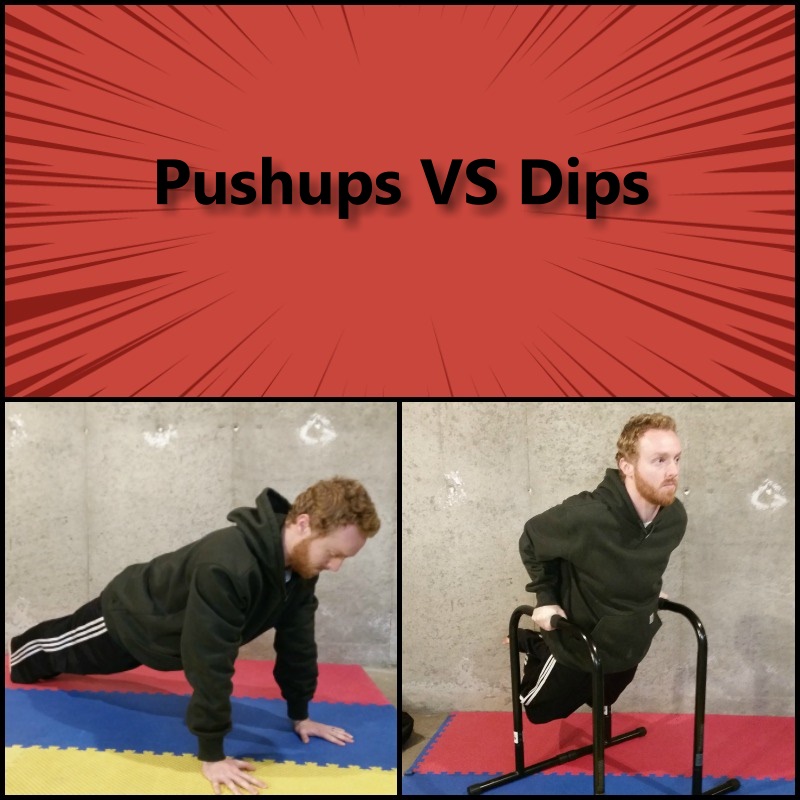
QUESTION: John, Can you explain the different benefits of pushups vs. dips? Which one do you recommend?
This question comes up a lot: which exercise is better: pushups or dips? The exercises I’m asked about often vary, but the answer is almost always the same. It depends on who you are and what you’re training for, among other things.
So, it’s not a question of which exercise is better – period. It’s a question of which exercise is better for YOU and your unique training goals.
So, in this post, you’ll learn which exercise you should prioritize in your program.
Pushups VS Dips
Pushups and dips are both upper body pushing (i.e. pressing) exercises that emphasize the chest, shoulders, triceps, and core musculature in different ways and to varying degrees. Each exercise has a distinct set of pros and cons, and this video will walk you through them.
Note: this is a comparison between the pushup “family” of exercises (i.e. the full spectrum of pushup variations) and the parallel-bar dip “family” of exercises (i.e. not bench-supported dips).
Key Points
Pushups
- Horizontal pushing exercise
- A good beginner progression for dips (i.e. prerequisite) because it’s an easier exercise
- Targets more overall musculature than dips
- More versatile than dips: lots of variations such as incline/decline, hand width, one arm progressions, stability tools (med ball, etc.), plyometrics, etc.
- Easier to scale to different skill levels, especially for beginners
- Can be done anywhere with no equipment
- Can be done with one arm to greatly increase strength challenge along with other unilateral training benefits
Dips
- Vertical pushing exercise
- More difficult (i.e. advanced) than pushups because of fewer bases of support, less musculature targeted, and more body weight being lifted.
- Generally target the triceps more, along with anterior deltoids and lower pecs
- Not as versatile – fewer variations available and you need some equipment, but you can alter your form to focus on a certain training goals (e.g. leaning forward to focus more on the chest or maintaining an upright posture to focus more on the triceps)
- Require more shoulder mobility due to a deeper ROM
- Tends to aggravate joints more often than pushups, likely due to poor shoulder mobility, which is common among fitness enthusiasts
- Easier to increase the load by using a dip belt to add weight (e.g. to maximize upper body strength and hypertrophy)
Pushups VS Dips: Which Exercise is Best?
They’re both great exercises for different reasons. So, a better question would be, “which exercise is more important to prioritize in your workout program?”
And for most fitness trainees who are interested in general health, fitness, functionality, and quality of life, I think they would be better served with pushups for a few reasons. First, they are a more versatile exercise that can be used for a lot of different training goals. Second, pushups are more easily scalable than dips. So, anyone – at any skill level – can find a pushup exercise that will properly challenge them. Plus, there are many progressions, such as one-arm pushups, that can be used to cater the exercise for a specific purpose. Third, you can do them anywhere with no equipment. Also, in my experience, they tend to be easier on the joints, particularly the shoulders, for most trainees. So, if you’ve gone through this entire guide, and you’re still not sure which exercise you should be focusing on, start with pushups.
That said, if you have already mastered the basic pushup, and want to take your upper body strength training to the next level, dips would be the next logical step. They are a more advanced strength exercise that will help to maximize your upper body strength and muscle development.
The Bottom Line
Both pushups and dips are great exercises with unique pros and cons, and I think that if you can, you should do both regularly. So, if you can perform both pushups, dips, and their many variations with proper form and without pain, you should take advantage of them both. You’ll get better overall results and more well-rounded strength and muscle development from including both in your workout program.
More Information
- How to do Pushups with Optimal Technique For Better Results and Less Injuries
- How to do Dips With Optimal Technique
- How Many Pushups Should I Be Able To Do?
- Knuckle Pushups VS Traditional Pushups: Which is Better?
- The Elbow Plank VS Pushup-Position Plank
If you found this article helpful, please share it with your friends:
.jpg)
![]()
Health-First Fitness Coach
P.S. If you liked this post, then please signup for the newsletter, or follow me on Facebook or Twitter for daily updates and other interesting info.